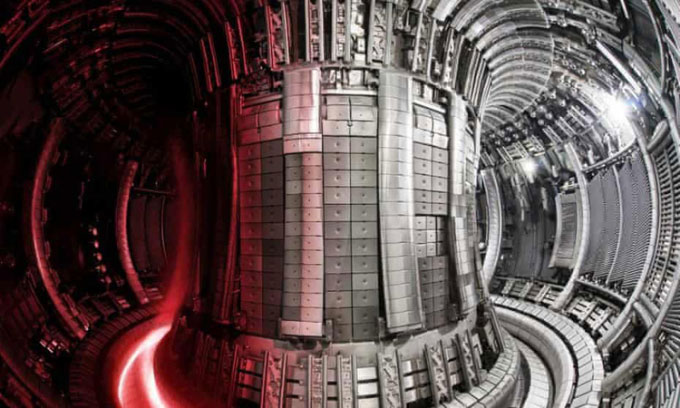JET Reactor Sets New Record by Producing 59 Megajoules of Energy in a 5-Second Reaction
A fusion experiment has achieved a new record for energy production on Earth by utilizing the same type of reaction that powers the Sun. Specifically, the fusion reactor of the Joint European Torus (JET) project in the UK generated 59 megajoules of energy (equivalent to about 14 kg of TNT) during a reaction lasting 5 seconds, more than double the previous record of 21.7 megajoules set by JET in 1997.

Inside the JET reactor, where the experiment produced 59 megajoules of energy. (Photo: UKAEA)
The JET expert team announced the new results on February 9, following over two decades of experimentation and improvements at the Culham Centre for Fusion Energy in Oxfordshire, England. This is considered a significant milestone on the path to making fusion a sustainable and viable low-carbon energy source.
The JET reactor is designed to contain plasma, or highly ionized gases, heated to 150 million degrees Celsius—ten times hotter than the core of the Sun. At such high temperatures, atomic nuclei can fuse together to form new elements, releasing tremendous amounts of energy. This fusion reaction is similar to what powers the Sun, albeit at significantly lower temperatures because stars have gravity to assist the process.
Experiments at JET focus on testing the feasibility of fusion reactions using a type of fuel derived from two isotopes of hydrogen: deuterium and tritium. These can combine to form helium gas. The new results indicate that this is feasible and provide crucial information for ITER, a larger fusion project currently being developed in southern France. ITER is expected to begin burning deuterium-tritium fuel in 2035.
If the ITER project proceeds successfully, experts will build a power plant in Europe and connect it to the electrical grid. Fusion is a highly promising energy source as it does not emit greenhouse gases. One kilogram of fusion fuel contains energy approximately 10 million times greater than that of one kilogram of coal, oil, or gas.
Deuterium is abundant in seawater, but tritium is extremely rare and is produced in nuclear reactors. Future fusion plants, including ITER, are expected to produce tritium fuel by using high-energy neutrons released when deuterium and tritium fuse to separate lithium metal into tritium and helium.
The JET experiment released fusion energy for just 5 seconds but demonstrated that this type of fuel can burn sustainably, according to Dr. Mark Wenman, a nuclear materials expert at the Royal College of London. “It has been a long time since they set a record like this, and it is an important milestone on the path to proving that fusion is a sustainable and viable energy source for the future,” he said.
“Five seconds may not sound like much, but if you can burn it for 5 seconds, you could likely stabilize it and burn for many minutes, hours, or even days. That is what you need to build a fusion power plant,” Wenman added.


















































